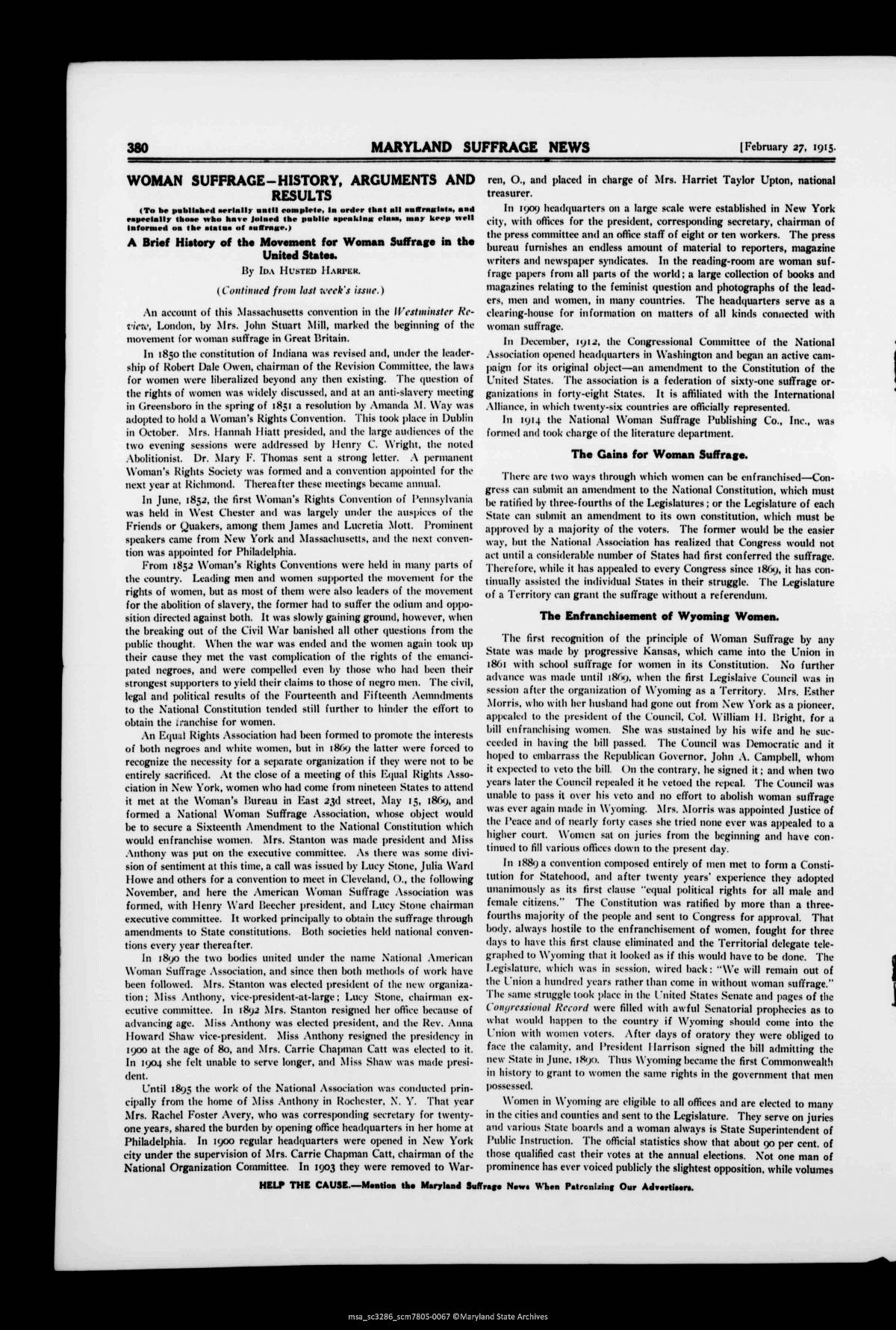|
380
MARYLAND SUFFRAGE NEWS
[February 27, 1915.
WOMAN SUFFRAGE-HISTORY, ARGUMENTS AND
RESULTS
(To lit* |tiil»IUHi-.l aprlall) mull <>oiii|»lrl«-. In arilrr Hint Mil BBlfraa-lala, and
rapaclatll Hume who hair Joined III.- pnbllf n|M-i.l.lnu vlumm, mr ke.-|. well
lufortiM'il mii lilt' alataa of minnm.-. I
A Brief History of the Movement for Woman Suffrage in the
United State..
By Ida Hlsted Harper.
( Continued from last ~onding secretary, chairman of
the press committee and an office staff of eight or ten workers. The press
bureau furnishes an endless amount of material to reporters, magazine
writers and newspaper syndicates. In the reading-room are woman suf-
frage papers from all parts of the world: a large collection of books and
magazines relating to the feminist question and photographs of the lead-
ers, men and women, in many countries. The headquarters serve as a
clearing-house for information on matters of all kinds connected with
woman suffrage.
In December, itju, the Congressional Committee of the National
Association opened headquarters in Washington anil began an active cam-
paign for its original object—an amendment to the Constitution of the
United States. The association is a federation of sixty-one suffrage or-
ganizations in forty-eight States. It is affiliated with the International
Alliance, in which twenty-six countries are officially represented.
In iyi4 the National Woman Suffrage Publishing Co., Inc., was
formed and took charge of the literature department.
The Gain* for Woman Suffrage.
There are two ways through which women can be enfranchised—Con-
gress can submit an amendment to the National Constitution, which must
be ratified by three-fourths of the Legislatures ; or the Legislature of each
Slate can submit an amendment to its own constitution, which must be
approved by a majority of the voters. The former would be the easier
way, but the National Association has realized that Congress would not
act until a considerable number of Slates had first conferred the suffrage.
Therefore, while it has appealed to every Congress since i860, it has con-
tinually assisted the individual States in their struggle. The Legislature
of a Territory can grant the suffrage without a referendum.
The Enfranchisement of Wyoming Women.
The first recognition of the principle of Woman Suffrage by any
State was made by progressive Kansas, which came into the Union in
1801 with school suffrage for women in its Constitution. No further
advance was made until i8ng, when the first Legislaive Council was in
session after the organization of Wyoming as a Territory. Mrs. Ksthcr
.Morris, who with her husband had gone out from New York as a pioneer,
appealed to the president of the Council, Col. William II. Bright, for a
bill enfranchising women. She was sustained by his wife and he suc-
ceeded in having the bill passed. The Council was Democratic and it
hoped to embarrass the Republican Governor, John A. Campbell, whom
it expected to veto the bill. ()n the contrary, he signed it; and when two
years later the Council repealed it he vetoed the repeal. The Council was
unable to pass it over his veto and no effort to abolish woman suffrage
was ever again made in Wyoming. Mrs. Morris was appointed Justice of
the I'eace and of nearly forty cases she tried none ever was appealed to a
higher court. Women sat on juries from the beginning and have con-
tinued to fill various offices down lo the present dav.
In i88i)a convention composed entirely of men met to form a Consti-
tution for Statehood, and after twenty years' experience they adopted
unanimously as its first clause "equal political rights for all male and
female citizens." The Constitution was ratified by more than a three-
fourths majority of the people and sent to Congress for approval. That
body, always hostile to the enfranchisement of women, fought for three
days to have this first clause eliminated and the Territorial delegate tele-
graphed to Wyoming that it looked as if this would have to be done. The
Legislature, which was in session, wired back: "We will remain out of
the Union a hundred years rather than come in without woman suffrage."
The same struggle took place in the United Slates Senate and pages of the
Coiu/rcssiomil Record were filled with awful Senatorial prophecies as to
what would happen to the country if Wyoming should come into the
Union with women voters. After days of oratory they were obliged to
face the calamity, and President Harrison signed the bill admitting the
new Stale in June. iRc/i. Thus Wyoming became the first Commonwealth
in history to grant to women the same rights in the government that men
possessed.
Women in Wyoming are eligible to all offices and are elected to many
in the cities and counties and sent to the Legislature. They serve on juries
and various State boards and a woman always is State Superintendent of
Public Instruction. The official statistics show that about 90 per cent, of
those qualified cast their votes at the annual elections. Not one man of
prominence has ever voiced publicly the slightest opposition, while volumes
HELP THE CAUSE— M.ntion Ik* Maryland Soffr.ae N.w. Whan Palronliinf Our Ad.artLan.
|

